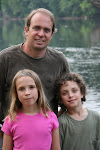
On Thanksgiving Day, Sam and I made a bridge from a little island in the creek to the marshy side we rarely go, where he now “claims” territory by whacking away the dried stems of the plants that are too thick to walk through in summer. We put down stones as pillars and laid a piece of old oak fencing across them. It wobbles a little when you walk across, but so do all bridges to playland.
Elliot and I made a wreath from clippings we could find, not only the green of white pine and cedar but boxwood and yew too, and then some red in the form of bittersweet and the berries from plant I forget (but should know), and finally some thistle and pine cones. We found a few feathers too, a cardinal and maybe a mockingbird—those went in as well.
We also hiked to Devil’s Marbleyard (a hike with an interesting name). It’s a family tradition to take to the mountains rather than the malls around Thanksgiving. We took some other kids with us this year to share in the fun. They hiked fast and together, leaving my wife and I in the back to enjoy the quiet. The day was warm and bright and we spotted a six-inch brook trout in the stream. When we got to base of the marble yard, chaos and noise reigned, as if Mr. Lucifer himself let loose on the scene.
Some kids immediately wanted to scale the massive boulders to the top, while some were more tentative and wanted a hand stepping from rock to massive rock. One boy decided to stay on the trail. If he was trying to get away from the shouts and noise, he choose the right path. But after a few minutes we heard no sound from him, and he did not return our shouts over the rock field. We began to get nervous. I lept up the rocks as fast as I could. Still no sign or sound. I went farther up the trail, which now split away from the rock field. Then I re-traced his steps, worried I’d find him lying beneath some steep rock face. Still no boy. I imagined calling the Forest Service for rescue. Imagined calling his mother with the bad news. So I dropped my pack and ran back up the trail, past where I had been before. There was a teary-eyed boy, afraid he had gotten lost in the woods, walking back down. We don’t know exactly how it happened: I guess I should have made sure he know that the rocks were our destination. And he by now knows not to leave the group on such hikes. I think he was wary of the rocks and thought the only way to be “one of the kids” was to hike to the top by way of the trail, but the trail left the rocks, headed off for another ridge.
Once he calmed down, he asked about bird sounds. Apparently, one bird was making a “beep beep” sound and this seemed to haunt him with his situation: alone and frightened. And then, at a happy reunion over lunch on the rocks, one of the girls did a tumble and nearly landed on her skull. And at the bottom of the hike, Elliot and her two friends walked off the blue-blazed trail onto a horse trail. Lagging behind, my wife and I heard their shouts. What’s funny here is that this hike borders a juvenile correctional facility, so they nearly wandered into protective custody. “Oh, come to join our institution, have we girls?”
What kind of bird was it? No doubt a demon one. The devil’s own. This is a great hike, but if we go again, we will be by ourselves.







